Unit 4 Space Exploration 课件(共14张PPT) 2025-2026学年人教版2019必修第三册
文档属性
| 名称 | Unit 4 Space Exploration 课件(共14张PPT) 2025-2026学年人教版2019必修第三册 |
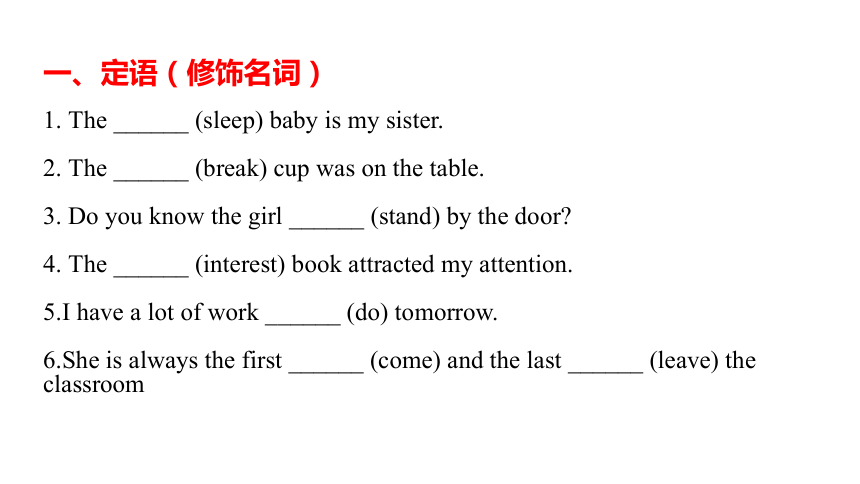
|
|
| 格式 | pptx | ||
| 文件大小 | 105.7KB | ||
| 资源类型 | 教案 | ||
| 版本资源 | 人教版(2019) | ||
| 科目 | 英语 | ||
| 更新时间 | 2025-06-18 15:49:40 | ||
图片预览

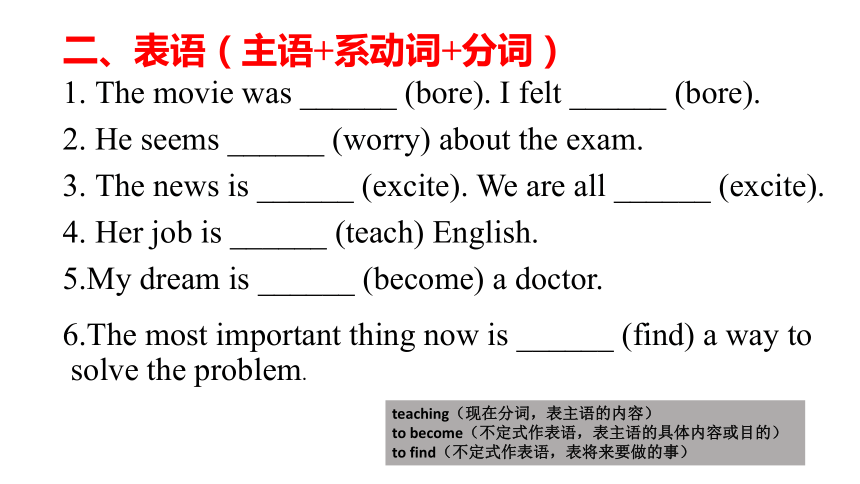

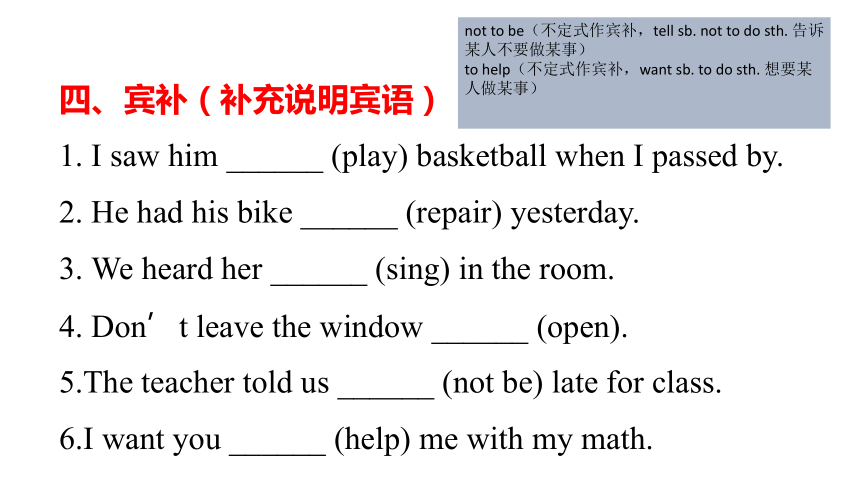
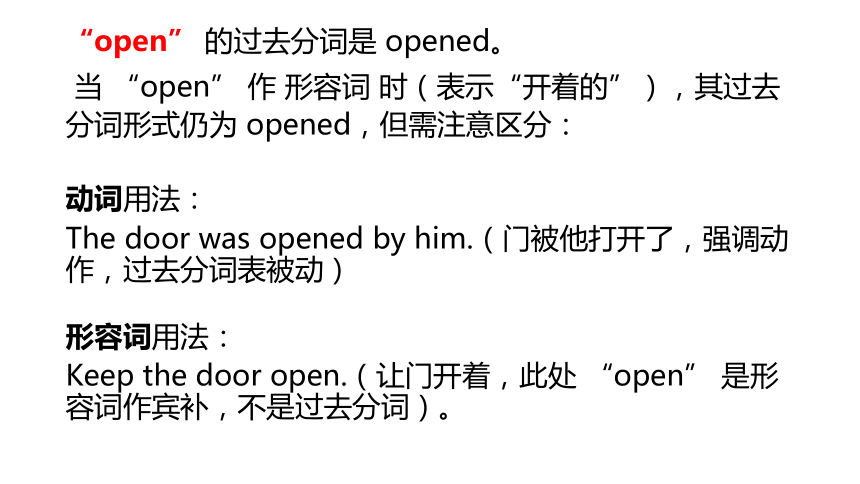
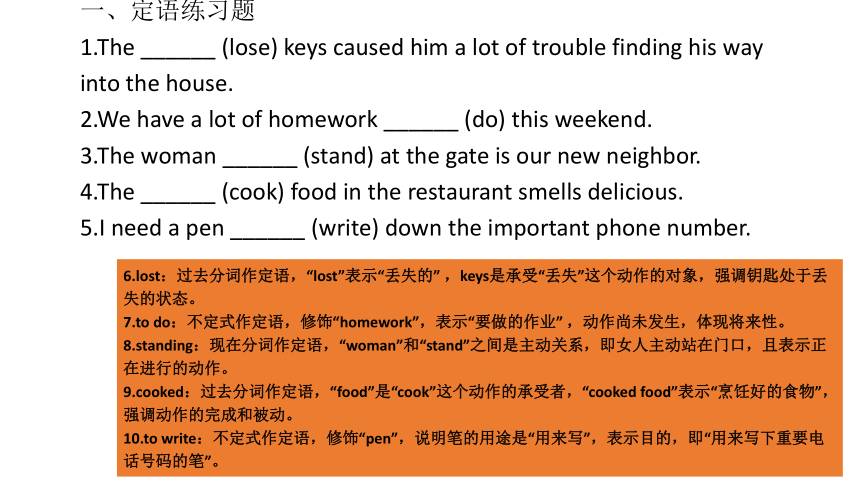

文档简介
(共14张PPT)
一、定语(修饰名词)
1. The ______ (sleep) baby is my sister.
2. The ______ (break) cup was on the table.
3. Do you know the girl ______ (stand) by the door
4. The ______ (interest) book attracted my attention.
5.I have a lot of work ______ (do) tomorrow.
6.She is always the first ______ (come) and the last ______ (leave) the
classroom
二、表语(主语+系动词+分词)
1. The movie was ______ (bore). I felt ______ (bore).
2. He seems ______ (worry) about the exam.
3. The news is ______ (excite). We are all ______ (excite).
4. Her job is ______ (teach) English.
5.My dream is ______ (become) a doctor.
6.The most important thing now is ______ (find) a way to
solve the problem.
teaching(现在分词,表主语的内容)
to become(不定式作表语,表主语的具体内容或目的)
to find(不定式作表语,表将来要做的事)
三、状语(修饰动作或句子)
1. ______ (see) from the sky, the earth looks blue.
2. ______ (not finish) the task, he stayed up late.
3. ______ (give) a gift, she smiled happily.
4. The teacher came in, ______ (hold) a book.
5.______ (get) there on time, we started early in the morning.
6.He worked day and night ______ (pay) off his debt.
Not having finished(完成式现在分词,表主动且先于谓语
To get(不定式作目的状语,表目的)
to pay(不定式作目的状语,表目的)
四、宾补(补充说明宾语)
1. I saw him ______ (play) basketball when I passed by.
2. He had his bike ______ (repair) yesterday.
3. We heard her ______ (sing) in the room.
4. Don’t leave the window ______ (open).
5.The teacher told us ______ (not be) late for class.
6.I want you ______ (help) me with my math.
not to be(不定式作宾补,tell sb. not to do sth. 告诉某人不要做某事)
to help(不定式作宾补,want sb. to do sth. 想要某人做某事)
“open” 的过去分词是 opened。
当 “open” 作 形容词 时(表示“开着的”),其过去分词形式仍为 opened,但需注意区分:
动词用法:
The door was opened by him.(门被他打开了,强调动作,过去分词表被动)
形容词用法:
Keep the door open.(让门开着,此处 “open” 是形容词作宾补,不是过去分词)。
一、定语练习题
1.The ______ (lose) keys caused him a lot of trouble finding his way into the house.
2.We have a lot of homework ______ (do) this weekend.
3.The woman ______ (stand) at the gate is our new neighbor.
4.The ______ (cook) food in the restaurant smells delicious.
5.I need a pen ______ (write) down the important phone number.
6.lost:过去分词作定语,“lost”表示“丢失的” ,keys是承受“丢失”这个动作的对象,强调钥匙处于丢失的状态。
7.to do:不定式作定语,修饰“homework”,表示“要做的作业” ,动作尚未发生,体现将来性。
8.standing:现在分词作定语,“woman”和“stand”之间是主动关系,即女人主动站在门口,且表示正在进行的动作。
9.cooked:过去分词作定语,“food”是“cook”这个动作的承受者,“cooked food”表示“烹饪好的食物”,强调动作的完成和被动。
10.to write:不定式作定语,修饰“pen”,说明笔的用途是“用来写”,表示目的,即“用来写下重要电话号码的笔”。
成分 现在分词(-ing) 过去分词(-ed) 不定式(to do)
定语 表主动、进行(a running dog 正在跑的狗) 表被动、完成(a broken pen 坏了的笔) 表将要发生的动作(the meeting to be held 将要举行的会议)
表语 修饰物(The story is interesting.) 修饰人(I am interested.我很感兴趣) 表主语的具体内容或目的(My plan is to travel.)
状语 主动关系(Hearing the news, she laughed.) 被动关系(Seen from here, it’s beautiful.) 表目的、原因、结果等(He came to see me. 表目的)
宾补 宾语主动做(watch sb. doing 看某人正在做) 宾语被动承受(have sth. done 让某事被做) 表示让宾语做某事(ask sb. to do 要求某人做)
不定式(to do)和现在分词(-ing)作表语时,虽都可描述主语内容,但在动作属性、时间指向和语义侧重上有明显区别
一、动作属性:
具体目的 vs 持续性质
不定式(to do):
侧重具体、一次性的动作或未发生的目的,强调 “主语想要做 / 将要做的事”。
例:
My goal is to learn a new language.(目标是 “要学”,具体动作)
His plan is to fix the car tomorrow.(计划是将来要做的事)
现在分词(-ing):
侧重主语的持续性质、特征或习惯性行为,强调 “主语本身是做什么的”。
例:
Her job is teaching English.(工作的性质是 “教英语”,持续行为)
His hobby is collecting stamps.(爱好是 “集邮”,习惯性动作)
不定式(to do)和现在分词(-ing)作表语时,虽都可描述主语内容,但在动作属性、时间指向和语义侧重上有明显区别
二、时间指向:
将来 vs 当下
不定式(to do):
动作发生在将来,与主语的 “意图、计划” 相关。
例:
The next step is to design a new logo.(下一步要设计,还未发生)
Our task is to finish the report by Friday.(任务是将来完成)
现在分词(-ing):
动作与主语的状态同时存在,描述当前的属性或内容。
例:
The movie is boring.(电影本身 “令人无聊”,当下的性质)
His favorite activity is playing chess.(下棋是他现在的爱好)
不定式(to do)和现在分词(-ing)作表语时,虽都可描述主语内容,但
有明显区别
三、语义侧重:
具体动作 vs 抽象概念
不定式(to do):
强调具体动作的过程或目的,常与主语的 “计划、目标、责任” 等搭配。
例:
My dream is to become a doctor.(梦想是具体的职业目标)
The purpose of the meeting is to discuss the problem.(会议目的是具体动作)
现在分词(-ing):
强调抽象的概念或内容,常与主语的 “工作、爱好、性质” 等搭配。
例:
Her passion is helping others.(热情是抽象的助人行为)
The book’s main topic is exploring human emotions.(主题是抽象的探索)
二、表语练习题
11.The documentary about nature was so ______ (fascinate) that I watched it twice.
12.After the long hike, all of us were ______ (tire) but happy.
13.My plan for the summer holiday is ______ (visit) my grandparents in the countryside.
14.The ending of the movie is ______ (shock), and most viewers felt ______ (shock).
15.Her hobby is ______ (collect) stamps from different countries.
16.fascinating:现在分词作表语,修饰物“documentary” ,说明纪录片本身具有“令人着迷的”性质,用来描述事物给人的感受。
17.tired:过去分词作表语,修饰人“all of us”,表示“我们”的感受是“疲惫的” ,强调人内心的感觉。
18.to visit:不定式作表语,说明主语“plan”的具体内容是“去乡下看望祖父母” ,体现计划的目的和内容。
19.shocking; shocked:“shocking”是现在分词,修饰“ending”,说明电影结局本身是“令人震惊的”;“shocked”是过去分词,修饰“viewers”,表示观众的感受是“感到震惊的” 。
20.collecting:现在分词作表语,说明主语“hobby”的内容是“收集邮票” ,表示经常性、习惯性的行为。
三、状语练习题
21.______ (look) out of the window, she saw a beautiful rainbow after the rain.
22.______ (give) another chance, he promised to do better in the competition.
23.They started early in the morning ______ (catch) the first train.
24.______ (not receive) a reply, she decided to send another email.
25.______ (compare) with last year's sales, this year's figures have increased significantly.
26.Looking:现在分词作时间状语,“she”和“look”之间是主动关系,即她主动看向窗外,且“look”和“saw”这两个动作几乎同时发生 。
27.Given:过去分词作条件状语,“he”和“give”之间是被动关系,即他被给予机会 ,表示“如果被给予另一次机会”这样的条件。
28.to catch:不定式作目的状语,“start early”的目的是“catch the first train” ,表示为了实现某个目标而采取的行动。
29.Not having received:现在分词的完成式作原因状语,“she”和“receive”是主动关系,且“没有收到回复”这个动作发生在“决定再发一封邮件”之前,所以用完成式,强调动作的先后顺序 。
pared:过去分词作比较状语,“this year's figures”和“compare”之间是被动关系,即今年的数据被拿来和去年的销售数据作比较 。
四、宾补练习题
31.I heard her ______ (sing) a sweet song in the next room.
32.He had his hair ______ (cut) before the job interview.
33.The teacher asked the students ______ (hand) in their homework on time.
34.We watched the cat ______ (chase) a mouse across the yard.
35.Don't leave the water ______ (run) when you brush your teeth.
36.singing:现在分词作宾补,“her”和“sing”之间是主动关系,且强调“听到她正在唱歌” ,表示动作正在进行。
37.cut:过去分词作宾补,“hair”和“cut”之间是被动关系,“have sth. done”表示让某事被做,即他让头发被剪掉 。
38.to hand:不定式作宾补,“ask sb. to do sth.”是固定搭配,“students”是“hand in”这个动作的执行者,老师要求学生去执行交作业这个动作 。
39.chasing:现在分词作宾补,“cat”和“chase”之间是主动关系,强调观看猫追逐老鼠这个正在进行的动作过程 。
running:现在分词作宾补,“water”和“run”之间是主动关系,“leave sth. doing”表示使某物处于某种持续的动作状态,即不要让水在刷牙的时候一直流着
成分 现在分词(-ing) 过去分词(-ed) 不定式(to do)
定语 表主动、进行(a running dog 正在跑的狗) 表被动、完成(a broken pen 坏了的笔) 表将要发生的动作(the meeting to be held 将要举行的会议)
表语 修饰物(The story is interesting.) 修饰人(I am interested.我很感兴趣) 表主语的具体内容或目的(My plan is to travel.)
状语 主动关系(Hearing the news, she laughed.) 被动关系(Seen from here, it’s beautiful.) 表目的、原因、结果等(He came to see me. 表目的)
宾补 宾语主动做(watch sb. doing 看某人正在做) 宾语被动承受(have sth. done 让某事被做) 表示让宾语做某事(ask sb. to do 要求某人做)
一、定语(修饰名词)
1. The ______ (sleep) baby is my sister.
2. The ______ (break) cup was on the table.
3. Do you know the girl ______ (stand) by the door
4. The ______ (interest) book attracted my attention.
5.I have a lot of work ______ (do) tomorrow.
6.She is always the first ______ (come) and the last ______ (leave) the
classroom
二、表语(主语+系动词+分词)
1. The movie was ______ (bore). I felt ______ (bore).
2. He seems ______ (worry) about the exam.
3. The news is ______ (excite). We are all ______ (excite).
4. Her job is ______ (teach) English.
5.My dream is ______ (become) a doctor.
6.The most important thing now is ______ (find) a way to
solve the problem.
teaching(现在分词,表主语的内容)
to become(不定式作表语,表主语的具体内容或目的)
to find(不定式作表语,表将来要做的事)
三、状语(修饰动作或句子)
1. ______ (see) from the sky, the earth looks blue.
2. ______ (not finish) the task, he stayed up late.
3. ______ (give) a gift, she smiled happily.
4. The teacher came in, ______ (hold) a book.
5.______ (get) there on time, we started early in the morning.
6.He worked day and night ______ (pay) off his debt.
Not having finished(完成式现在分词,表主动且先于谓语
To get(不定式作目的状语,表目的)
to pay(不定式作目的状语,表目的)
四、宾补(补充说明宾语)
1. I saw him ______ (play) basketball when I passed by.
2. He had his bike ______ (repair) yesterday.
3. We heard her ______ (sing) in the room.
4. Don’t leave the window ______ (open).
5.The teacher told us ______ (not be) late for class.
6.I want you ______ (help) me with my math.
not to be(不定式作宾补,tell sb. not to do sth. 告诉某人不要做某事)
to help(不定式作宾补,want sb. to do sth. 想要某人做某事)
“open” 的过去分词是 opened。
当 “open” 作 形容词 时(表示“开着的”),其过去分词形式仍为 opened,但需注意区分:
动词用法:
The door was opened by him.(门被他打开了,强调动作,过去分词表被动)
形容词用法:
Keep the door open.(让门开着,此处 “open” 是形容词作宾补,不是过去分词)。
一、定语练习题
1.The ______ (lose) keys caused him a lot of trouble finding his way into the house.
2.We have a lot of homework ______ (do) this weekend.
3.The woman ______ (stand) at the gate is our new neighbor.
4.The ______ (cook) food in the restaurant smells delicious.
5.I need a pen ______ (write) down the important phone number.
6.lost:过去分词作定语,“lost”表示“丢失的” ,keys是承受“丢失”这个动作的对象,强调钥匙处于丢失的状态。
7.to do:不定式作定语,修饰“homework”,表示“要做的作业” ,动作尚未发生,体现将来性。
8.standing:现在分词作定语,“woman”和“stand”之间是主动关系,即女人主动站在门口,且表示正在进行的动作。
9.cooked:过去分词作定语,“food”是“cook”这个动作的承受者,“cooked food”表示“烹饪好的食物”,强调动作的完成和被动。
10.to write:不定式作定语,修饰“pen”,说明笔的用途是“用来写”,表示目的,即“用来写下重要电话号码的笔”。
成分 现在分词(-ing) 过去分词(-ed) 不定式(to do)
定语 表主动、进行(a running dog 正在跑的狗) 表被动、完成(a broken pen 坏了的笔) 表将要发生的动作(the meeting to be held 将要举行的会议)
表语 修饰物(The story is interesting.) 修饰人(I am interested.我很感兴趣) 表主语的具体内容或目的(My plan is to travel.)
状语 主动关系(Hearing the news, she laughed.) 被动关系(Seen from here, it’s beautiful.) 表目的、原因、结果等(He came to see me. 表目的)
宾补 宾语主动做(watch sb. doing 看某人正在做) 宾语被动承受(have sth. done 让某事被做) 表示让宾语做某事(ask sb. to do 要求某人做)
不定式(to do)和现在分词(-ing)作表语时,虽都可描述主语内容,但在动作属性、时间指向和语义侧重上有明显区别
一、动作属性:
具体目的 vs 持续性质
不定式(to do):
侧重具体、一次性的动作或未发生的目的,强调 “主语想要做 / 将要做的事”。
例:
My goal is to learn a new language.(目标是 “要学”,具体动作)
His plan is to fix the car tomorrow.(计划是将来要做的事)
现在分词(-ing):
侧重主语的持续性质、特征或习惯性行为,强调 “主语本身是做什么的”。
例:
Her job is teaching English.(工作的性质是 “教英语”,持续行为)
His hobby is collecting stamps.(爱好是 “集邮”,习惯性动作)
不定式(to do)和现在分词(-ing)作表语时,虽都可描述主语内容,但在动作属性、时间指向和语义侧重上有明显区别
二、时间指向:
将来 vs 当下
不定式(to do):
动作发生在将来,与主语的 “意图、计划” 相关。
例:
The next step is to design a new logo.(下一步要设计,还未发生)
Our task is to finish the report by Friday.(任务是将来完成)
现在分词(-ing):
动作与主语的状态同时存在,描述当前的属性或内容。
例:
The movie is boring.(电影本身 “令人无聊”,当下的性质)
His favorite activity is playing chess.(下棋是他现在的爱好)
不定式(to do)和现在分词(-ing)作表语时,虽都可描述主语内容,但
有明显区别
三、语义侧重:
具体动作 vs 抽象概念
不定式(to do):
强调具体动作的过程或目的,常与主语的 “计划、目标、责任” 等搭配。
例:
My dream is to become a doctor.(梦想是具体的职业目标)
The purpose of the meeting is to discuss the problem.(会议目的是具体动作)
现在分词(-ing):
强调抽象的概念或内容,常与主语的 “工作、爱好、性质” 等搭配。
例:
Her passion is helping others.(热情是抽象的助人行为)
The book’s main topic is exploring human emotions.(主题是抽象的探索)
二、表语练习题
11.The documentary about nature was so ______ (fascinate) that I watched it twice.
12.After the long hike, all of us were ______ (tire) but happy.
13.My plan for the summer holiday is ______ (visit) my grandparents in the countryside.
14.The ending of the movie is ______ (shock), and most viewers felt ______ (shock).
15.Her hobby is ______ (collect) stamps from different countries.
16.fascinating:现在分词作表语,修饰物“documentary” ,说明纪录片本身具有“令人着迷的”性质,用来描述事物给人的感受。
17.tired:过去分词作表语,修饰人“all of us”,表示“我们”的感受是“疲惫的” ,强调人内心的感觉。
18.to visit:不定式作表语,说明主语“plan”的具体内容是“去乡下看望祖父母” ,体现计划的目的和内容。
19.shocking; shocked:“shocking”是现在分词,修饰“ending”,说明电影结局本身是“令人震惊的”;“shocked”是过去分词,修饰“viewers”,表示观众的感受是“感到震惊的” 。
20.collecting:现在分词作表语,说明主语“hobby”的内容是“收集邮票” ,表示经常性、习惯性的行为。
三、状语练习题
21.______ (look) out of the window, she saw a beautiful rainbow after the rain.
22.______ (give) another chance, he promised to do better in the competition.
23.They started early in the morning ______ (catch) the first train.
24.______ (not receive) a reply, she decided to send another email.
25.______ (compare) with last year's sales, this year's figures have increased significantly.
26.Looking:现在分词作时间状语,“she”和“look”之间是主动关系,即她主动看向窗外,且“look”和“saw”这两个动作几乎同时发生 。
27.Given:过去分词作条件状语,“he”和“give”之间是被动关系,即他被给予机会 ,表示“如果被给予另一次机会”这样的条件。
28.to catch:不定式作目的状语,“start early”的目的是“catch the first train” ,表示为了实现某个目标而采取的行动。
29.Not having received:现在分词的完成式作原因状语,“she”和“receive”是主动关系,且“没有收到回复”这个动作发生在“决定再发一封邮件”之前,所以用完成式,强调动作的先后顺序 。
pared:过去分词作比较状语,“this year's figures”和“compare”之间是被动关系,即今年的数据被拿来和去年的销售数据作比较 。
四、宾补练习题
31.I heard her ______ (sing) a sweet song in the next room.
32.He had his hair ______ (cut) before the job interview.
33.The teacher asked the students ______ (hand) in their homework on time.
34.We watched the cat ______ (chase) a mouse across the yard.
35.Don't leave the water ______ (run) when you brush your teeth.
36.singing:现在分词作宾补,“her”和“sing”之间是主动关系,且强调“听到她正在唱歌” ,表示动作正在进行。
37.cut:过去分词作宾补,“hair”和“cut”之间是被动关系,“have sth. done”表示让某事被做,即他让头发被剪掉 。
38.to hand:不定式作宾补,“ask sb. to do sth.”是固定搭配,“students”是“hand in”这个动作的执行者,老师要求学生去执行交作业这个动作 。
39.chasing:现在分词作宾补,“cat”和“chase”之间是主动关系,强调观看猫追逐老鼠这个正在进行的动作过程 。
running:现在分词作宾补,“water”和“run”之间是主动关系,“leave sth. doing”表示使某物处于某种持续的动作状态,即不要让水在刷牙的时候一直流着
成分 现在分词(-ing) 过去分词(-ed) 不定式(to do)
定语 表主动、进行(a running dog 正在跑的狗) 表被动、完成(a broken pen 坏了的笔) 表将要发生的动作(the meeting to be held 将要举行的会议)
表语 修饰物(The story is interesting.) 修饰人(I am interested.我很感兴趣) 表主语的具体内容或目的(My plan is to travel.)
状语 主动关系(Hearing the news, she laughed.) 被动关系(Seen from here, it’s beautiful.) 表目的、原因、结果等(He came to see me. 表目的)
宾补 宾语主动做(watch sb. doing 看某人正在做) 宾语被动承受(have sth. done 让某事被做) 表示让宾语做某事(ask sb. to do 要求某人做)
